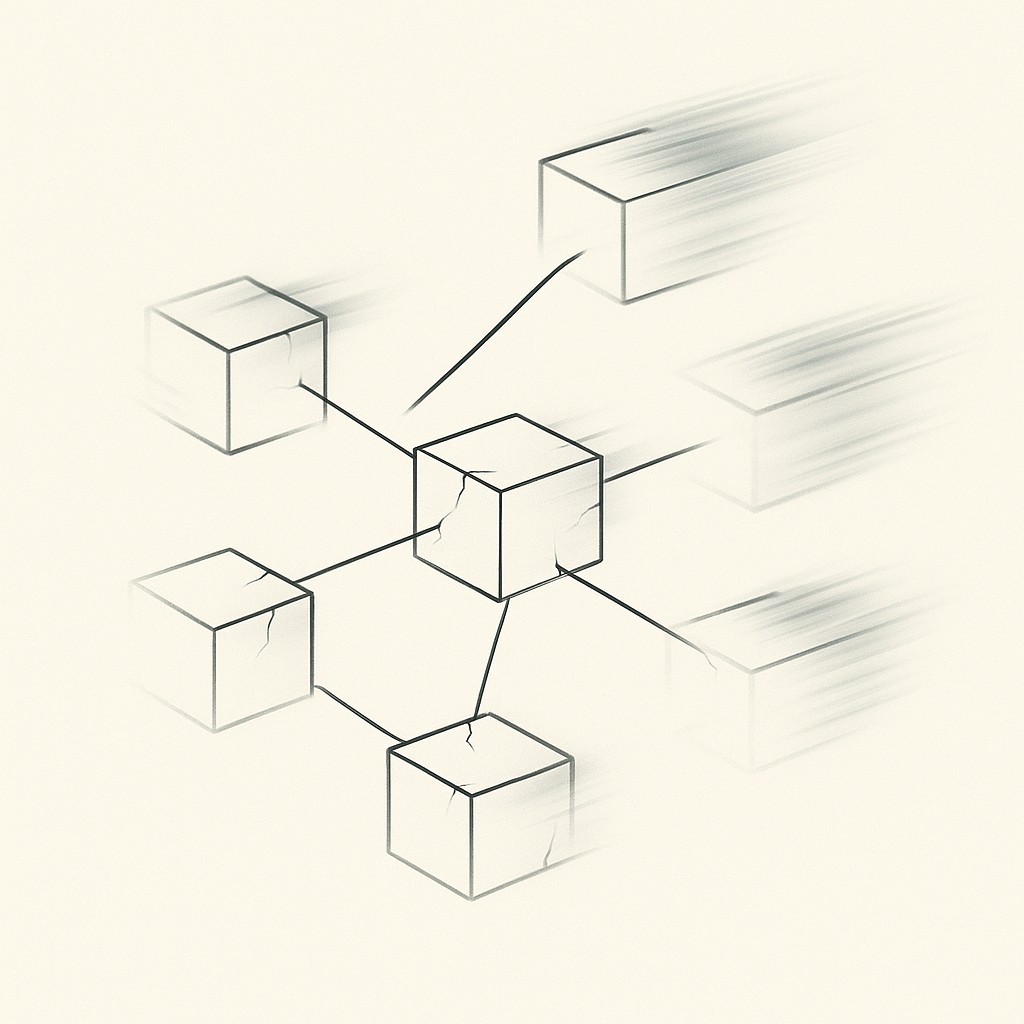Managing AI Development Complexity: Build Reliable Systems
Managing AI Development Complexity: Build Reliable Systems

When Velocity Becomes Fragility
For a while, using AI day-to-day felt like a superpower. Each new tool promised instant output and zero friction. Honestly, that rush never gets old at first. But after a few sprints, excitement quietly gave way to something closer to caution.
The real shift hit when the work stopped feeling faster—at least in a way that lasted. Suddenly, maintaining what we’d built became a matter of managing AI development complexity, not just an occasional cleanup or post-release polish. It crept into every morning, every week—a constant scramble to patch up logic, re-check integrations, hunt for edge cases. If you’re chasing speed right now, you’ll notice this turn. It’s less like finishing and more like trying not to regress.
Here’s what I wish I’d paid closer attention to. AI gives you the code or content you ask for, but it doesn’t see invisible constraints—the ones you never spell out until they break. So we ship, thinking things are “done,” but those cracks start to widen. Maybe a workflow looks smooth for 98% of users, but quietly fails for some, or piles up silent errors at the boundaries. It’s tempting to trust the surface. After all, it runs. But each of these almost-right artifacts stacks up invisible debt, and that debt is sneaky. A week or month later, whole systems can start to drift apart, failing for reasons no one can trace to a specific commit or document.
And when you start producing everything ten times faster, that risk multiplies too. Teams aren’t just juggling more outputs. We’re also coordinating across more tools, more hand-offs, more dependencies that subtly drift apart if we don’t lock down integration and review early. I’ve seen quiet fragmentation creep in overnight. You can’t skip alignment anymore—not if you want the things you’re building to fit together tomorrow.

Trust in systems changes here. “It compiles” isn’t enough. Correctness means actually pressure-testing what fits and what holds. Now, shipping is the beginning, not the end.
Cheap Generation, Expensive Entanglement
The classic error patterns have a new twist. Drift creeps in quietly as integrations harden around assumptions that nobody checks again, brittle handshakes between services or prompts start to multiply, and outputs look exactly right—until a real-world edge case cracks them open. Plausible but wrong code sails through code review because on the surface it matches the ticket. Content passes spellcheck and the quick read, but misses subtle constraints we only notice when a customer flags it. I’ve seen AI-generated SQL queries that executed cleanly but returned off-by-one errors, only discovered weeks later. Most AI artifacts look “done” right up until the moment they aren’t.
Not long ago, I got pulled into a marathon debugging session for an integration that had been running “fine” for weeks. Turns out, a tiny change in a dependent service caused silent failures in our workflows—no obvious logs, nothing flagged in testing. We found the root cause because someone remembered an odd warning buried in the commit messages from three versions back. It was one of those “how did anyone ever trace this?” moments. That kind of entanglement only gets worse as everything speeds up.
The new failures are different. Hallucinations will be silent, not loud. They fit the context, slip past reviewers, and blend into system logs until one off-kilter output triggers a cascade. If you’re not spotting signals early, the first real symptom is often user pain, not a red flag in testing.
Here’s how it plays out. A fast-shipped integration makes it through review but is one API version out of date. Everything passes—the regression, the smoke tests—until another team ships a change and suddenly you’re tracing odd behaviors through three services.
Shipping fast without wrecking everything is much harder. The hard truth now is that quality lives in coherence, not just in isolated output. If what you’re building doesn’t fit seamlessly into the wider system, speed becomes risk, not productivity.
The New Bottleneck: Managing AI Development Complexity From Speed to System Feedback
The bottleneck is no longer how fast you can generate code or content; managing AI development complexity is what decides whether momentum holds together. It’s whether you can manage growing complexity without losing coherence. What actually matters is maintenance, observability, coordination, and semantic validation. Fast creation is table stakes. Resilient integration is the advantage.
Six months ago, I used to think more automation meant less overhead. Now, I see it really just shifts the weight somewhere else. It’s easy to worry that investing in reliability, review loops, and friction-busting process will kill momentum. I get that—it’s always tempting to push non-glamorous work aside for the thrill of launching. But here’s my experience. Reliability and aligned progress actually compound over time, while invisible debt quietly erodes trust and slows everyone down later. The reason this feels hard is because success means fixing things you can’t easily see.
Here’s the shift that’s made a real difference for my teams. Systems-level feedback loops. Tight observability feeds small fixes before problems snowball. Strong alignment reduces painful collisions. Semantic checks catch “plausible-but-wrong” errors that would otherwise drift by. When we doubled down on these habits, tight observability and disciplined incident response loops slashed MTTR by 82% and MTTA by 97%, turning feedback into real reliability gains.
The future will reward teams who build loops that surface and correct drift daily, not quarterly. System feedback isn’t busywork. It’s how velocity turns into outcomes you can actually trust.
Turning Principles Into Practice
Start with a daily maintenance cadence, even if it feels like one more thing to track. Prioritizing small fixes, lightweight resilience work, and routine cleanup will keep complexity from compounding. If you keep up the rhythm, you’ll notice it gets easier to spot what needs fixing before it metastasizes.
Honestly, I think about observability the way I do a kitchen smoke detector—mostly silent, until it’s the only thing between you and disaster. I admit, I have a bit of a bias toward instruments that surface problems before they’re obvious. Without them, I’d miss subtle edge-case drifts and little dead ends that quietly break things. You don’t need a wall of dashboards.
Just invest in anomaly sniffers and traces that reliably flag context drift while it’s still a ripple, not a wave. I once ignored a silent alert for a week, convinced it was noise, and watched a simple API mismatch cascade into user complaints nobody could trace. Better signals don’t just help. They give you the breathing room to fix issues without playing whack-a-mole. It’s not glamorous work, but it keeps everything else honest.
Take alignment seriously before things turn brittle. Build out clear dependency maps; don’t just assume everyone knows what connects to what. Share roadmaps early with teams who own critical interfaces. Surprises shrink. Most important, run ruthless integration reviews to reduce coupling in AI before it gets locked in. You’ll save yourself from those painful after-the-fact rewrites that quietly burn hours and trust.
For semantic validation workflows, don’t stop at syntax. Run sharper reviews that check assumptions, integrations, and make sure each artifact fits the system you actually have, not the one you wish you had. The results are hard to argue with—semantic checks outperform syntax-only approaches, with AUROC values jumping from 0.691 to 0.790 on challenging model-task mixes, so you catch subtle “almost right” errors that normal checks would miss. That’s where the real reliability comes from, and it compounds as your ecosystem grows.
If you keep these patterns visible and routine, AI complexity management becomes attainable even as output grows. The work isn’t always loud, but it’s the difference between running fast today and actually building something that lasts.
Making Fast AI Reliable: Moves You Can Use Right Now
Before you ship the next fast batch of code or content, line up your dependencies early, confirm where integrations hand off, and set tripwires for observability so you’ll actually catch what breaks quietly later. Do this up front—even when pressure is high and the finish line looks close. You’ll thank yourself the next time an “invisible” error wants to slip past unnoticed.
When I say observability for AI systems, I mean not just logging and metrics. Think instrumenting critical paths, tracking semantic signals that show meaning (not just performance), and routing anomalies straight to whoever owns that piece, not a catch-all channel. Building this habit pays off because tight observability and clear incident response loops slash mean time to repair (MTTR) and mean time to acknowledge (MTTA) by huge margins. That’s the trade that turns surprises into manageable fixes.
Don’t skip what I call integration discipline. Follow integration gates best practices—run ruthless reviews, not just cursory checks. Actually verify that interface contracts work in the real setting—skip the wishful thinking—and build a living map of dependencies so you don’t crash into weird collisions down the road. If velocity tempts you to DIY integration checks, pause and reframe. It’s not about slowing down. It’s about avoiding being blindsided later.
Culture matters. Move credibility from “it runs” to “it survives pressure and complexity.” Admit where it’s easy to mistake code that compiles for code that stays coherent when things change. The teams I trust most keep callbacks visible, chasing pressure-tested, aligned systems, not shiny artifacts.
So keep shipping fast—I do, and I use AI every day to code, write, and create faster. But design your loops for complexity now, so the speed you gain turns into outputs you and everyone else can depend on.
Generate AI-powered content quickly, with clear prompts that encode goals, constraints, and review cues, so your drafts land closer to spec and require less rework.
If there’s a puzzle I still haven’t fully solved, it’s balancing the urge to chase speed with the discipline to build resilience. Sometimes I think I’ve got the calibration right, only to realize there’s another layer of hidden drift waiting. Maybe that’s just the cost of working at the frontier—velocity breeds fragile ground. The best I can do is stay open, keep my teams talking, and let feedback shape what comes next.
Enjoyed this post? For more insights on engineering leadership, mindful productivity, and navigating the modern workday, follow me on LinkedIn to stay inspired and join the conversation.
You can also view and comment on the original post here .
